Report on HR Challenges, Strategies, and Solutions at Rio Tinto
VerifiedAdded on 2020/03/16
|11
|3169
|38
Report
AI Summary
This report provides an in-depth analysis of the human resource challenges faced by Rio Tinto, a leading mining and metal corporation. It begins with an executive summary and table of contents, followed by an introduction that highlights Rio Tinto's global presence and business operations. The core of the report focuses on key HR challenges, including demographic issues such as aging workforce, diversity, and generation gaps; organizational image concerns, and labor supply and demand imbalances. For each challenge, the report recommends specific strategies, such as employee assessment, cross-cultural training, and maintaining a balance between labor supply and demand. Additional challenges discussed include high employee turnover, weak recruitment strategies, and poor leadership, with corresponding recommendations for improvement. The report emphasizes the importance of effective leadership, recruitment strategies, employee retention, and maintaining a positive organizational culture to ensure long-term success and competitiveness. The report concludes that effective human resource management is crucial for Rio Tinto to overcome challenges and achieve its goals.
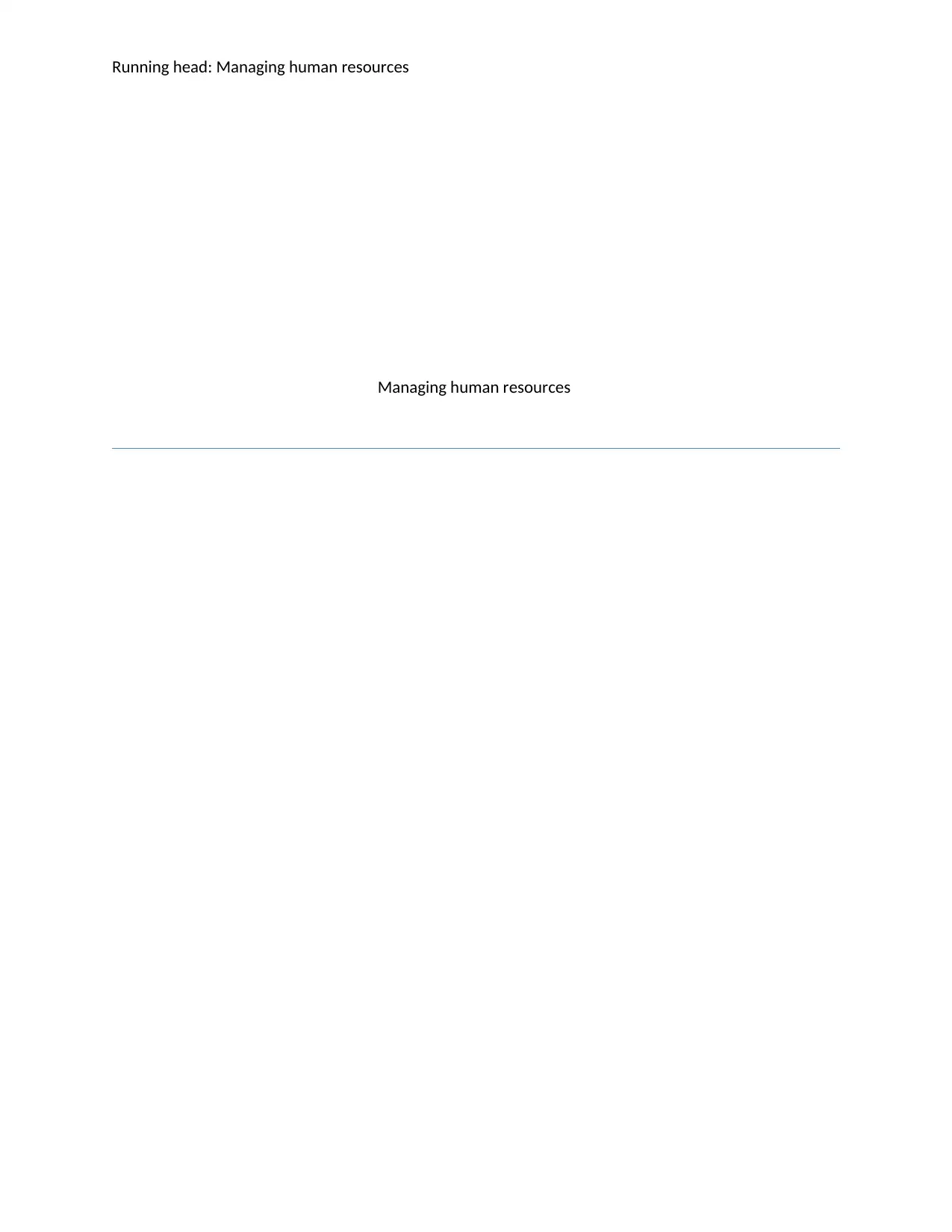
Running head: Managing human resources
Managing human resources
Managing human resources
Paraphrase This Document
Need a fresh take? Get an instant paraphrase of this document with our AI Paraphraser
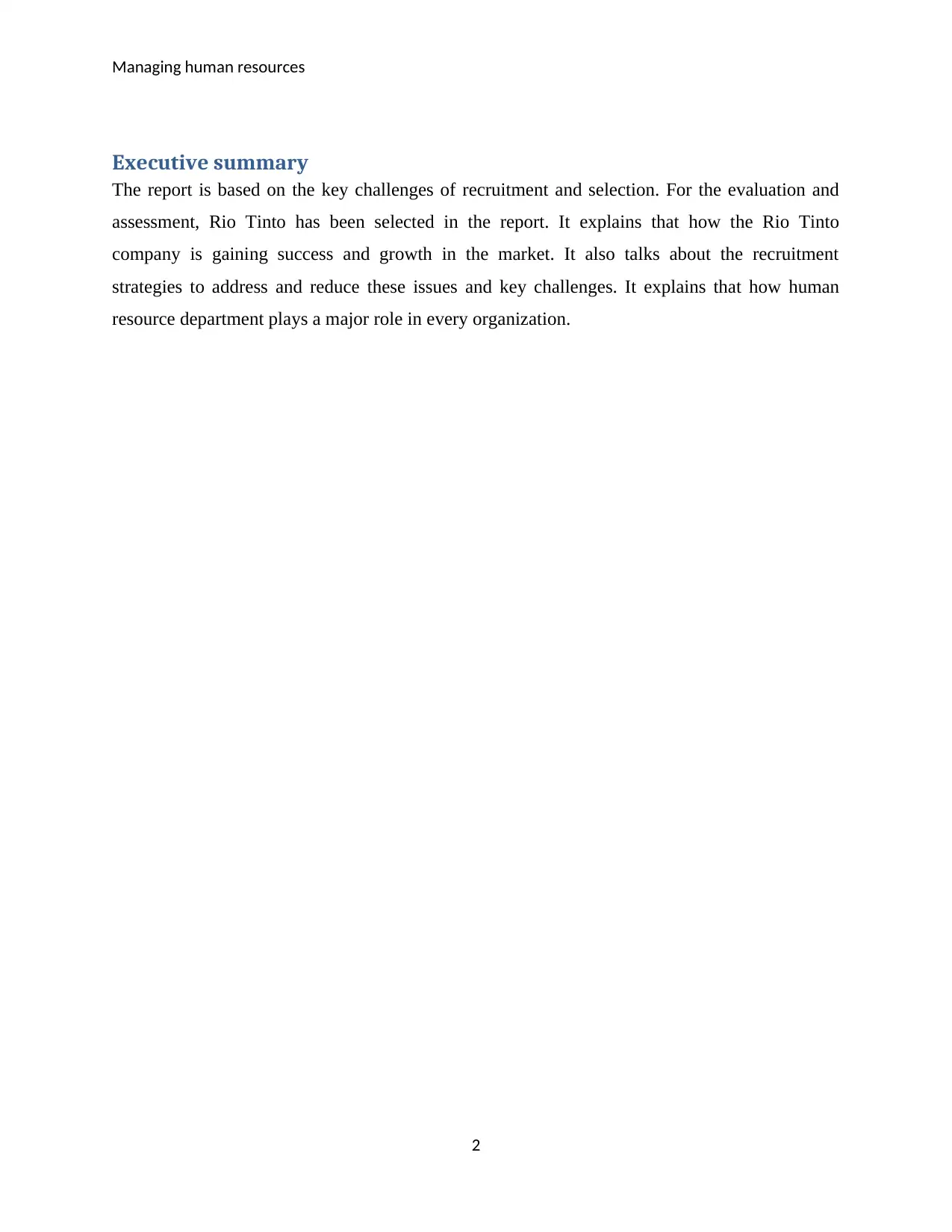
Managing human resources
Executive summary
The report is based on the key challenges of recruitment and selection. For the evaluation and
assessment, Rio Tinto has been selected in the report. It explains that how the Rio Tinto
company is gaining success and growth in the market. It also talks about the recruitment
strategies to address and reduce these issues and key challenges. It explains that how human
resource department plays a major role in every organization.
2
Executive summary
The report is based on the key challenges of recruitment and selection. For the evaluation and
assessment, Rio Tinto has been selected in the report. It explains that how the Rio Tinto
company is gaining success and growth in the market. It also talks about the recruitment
strategies to address and reduce these issues and key challenges. It explains that how human
resource department plays a major role in every organization.
2
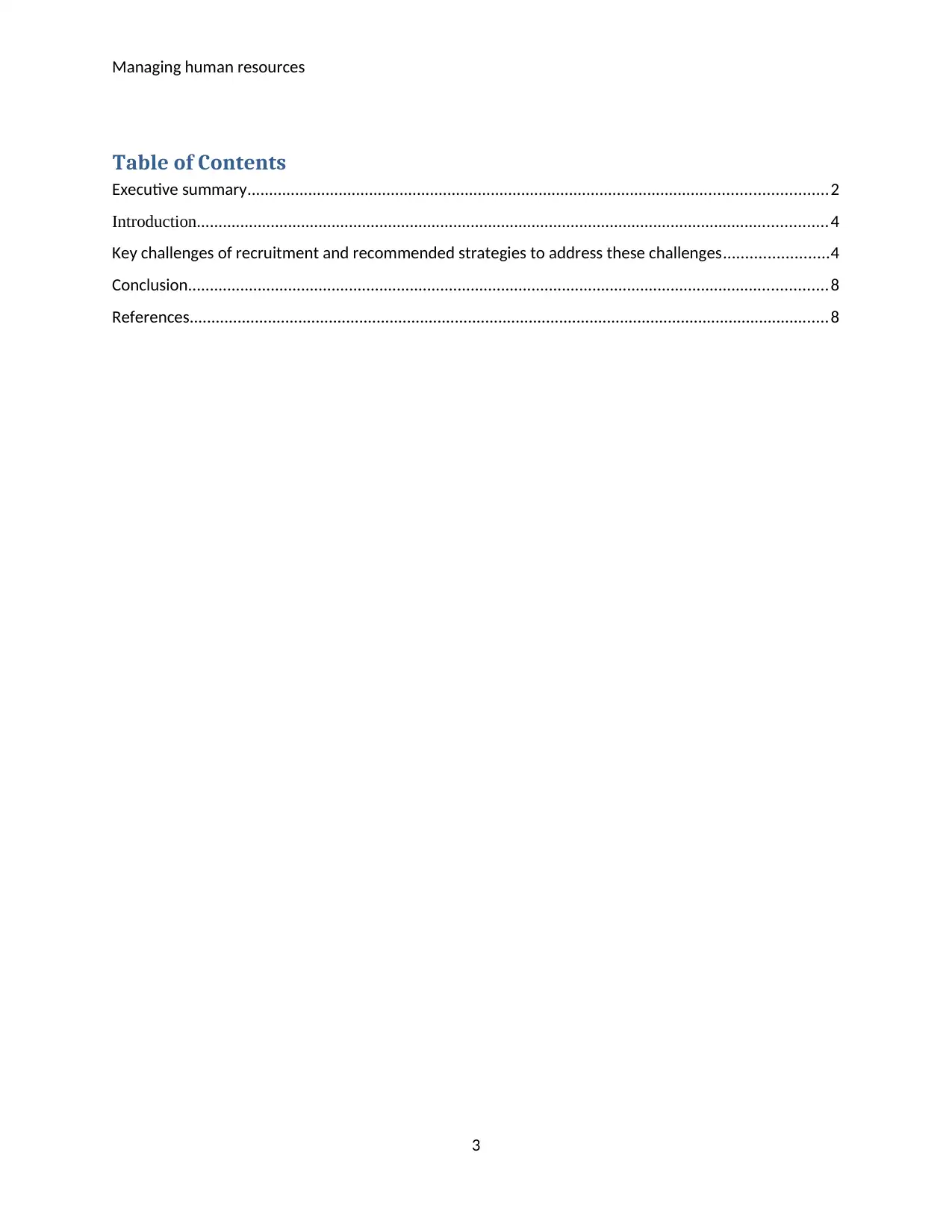
Managing human resources
Table of Contents
Executive summary.....................................................................................................................................2
Introduction.................................................................................................................................................4
Key challenges of recruitment and recommended strategies to address these challenges........................4
Conclusion...................................................................................................................................................8
References...................................................................................................................................................8
3
Table of Contents
Executive summary.....................................................................................................................................2
Introduction.................................................................................................................................................4
Key challenges of recruitment and recommended strategies to address these challenges........................4
Conclusion...................................................................................................................................................8
References...................................................................................................................................................8
3
⊘ This is a preview!⊘
Do you want full access?
Subscribe today to unlock all pages.

Trusted by 1+ million students worldwide
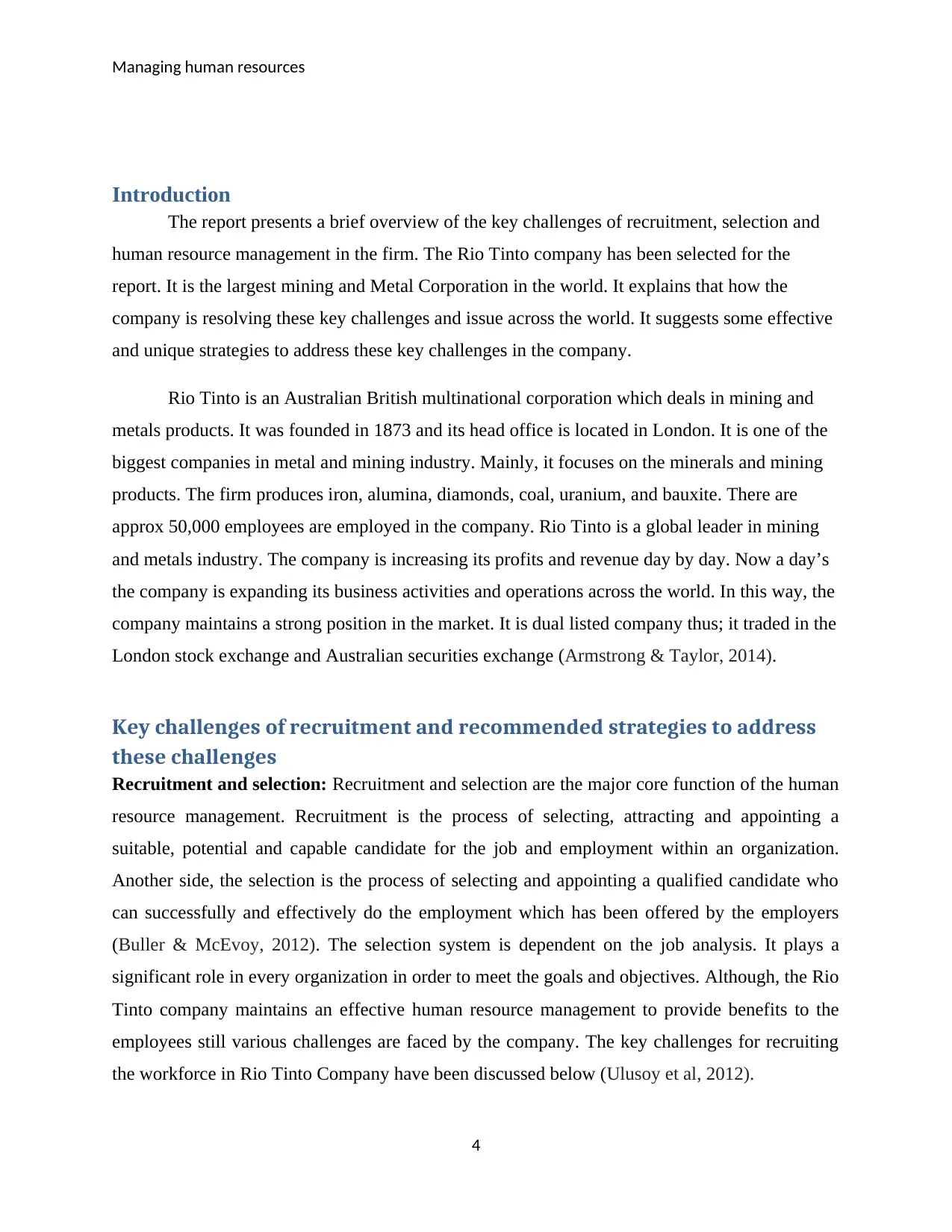
Managing human resources
Introduction
The report presents a brief overview of the key challenges of recruitment, selection and
human resource management in the firm. The Rio Tinto company has been selected for the
report. It is the largest mining and Metal Corporation in the world. It explains that how the
company is resolving these key challenges and issue across the world. It suggests some effective
and unique strategies to address these key challenges in the company.
Rio Tinto is an Australian British multinational corporation which deals in mining and
metals products. It was founded in 1873 and its head office is located in London. It is one of the
biggest companies in metal and mining industry. Mainly, it focuses on the minerals and mining
products. The firm produces iron, alumina, diamonds, coal, uranium, and bauxite. There are
approx 50,000 employees are employed in the company. Rio Tinto is a global leader in mining
and metals industry. The company is increasing its profits and revenue day by day. Now a day’s
the company is expanding its business activities and operations across the world. In this way, the
company maintains a strong position in the market. It is dual listed company thus; it traded in the
London stock exchange and Australian securities exchange (Armstrong & Taylor, 2014).
Key challenges of recruitment and recommended strategies to address
these challenges
Recruitment and selection: Recruitment and selection are the major core function of the human
resource management. Recruitment is the process of selecting, attracting and appointing a
suitable, potential and capable candidate for the job and employment within an organization.
Another side, the selection is the process of selecting and appointing a qualified candidate who
can successfully and effectively do the employment which has been offered by the employers
(Buller & McEvoy, 2012). The selection system is dependent on the job analysis. It plays a
significant role in every organization in order to meet the goals and objectives. Although, the Rio
Tinto company maintains an effective human resource management to provide benefits to the
employees still various challenges are faced by the company. The key challenges for recruiting
the workforce in Rio Tinto Company have been discussed below (Ulusoy et al, 2012).
4
Introduction
The report presents a brief overview of the key challenges of recruitment, selection and
human resource management in the firm. The Rio Tinto company has been selected for the
report. It is the largest mining and Metal Corporation in the world. It explains that how the
company is resolving these key challenges and issue across the world. It suggests some effective
and unique strategies to address these key challenges in the company.
Rio Tinto is an Australian British multinational corporation which deals in mining and
metals products. It was founded in 1873 and its head office is located in London. It is one of the
biggest companies in metal and mining industry. Mainly, it focuses on the minerals and mining
products. The firm produces iron, alumina, diamonds, coal, uranium, and bauxite. There are
approx 50,000 employees are employed in the company. Rio Tinto is a global leader in mining
and metals industry. The company is increasing its profits and revenue day by day. Now a day’s
the company is expanding its business activities and operations across the world. In this way, the
company maintains a strong position in the market. It is dual listed company thus; it traded in the
London stock exchange and Australian securities exchange (Armstrong & Taylor, 2014).
Key challenges of recruitment and recommended strategies to address
these challenges
Recruitment and selection: Recruitment and selection are the major core function of the human
resource management. Recruitment is the process of selecting, attracting and appointing a
suitable, potential and capable candidate for the job and employment within an organization.
Another side, the selection is the process of selecting and appointing a qualified candidate who
can successfully and effectively do the employment which has been offered by the employers
(Buller & McEvoy, 2012). The selection system is dependent on the job analysis. It plays a
significant role in every organization in order to meet the goals and objectives. Although, the Rio
Tinto company maintains an effective human resource management to provide benefits to the
employees still various challenges are faced by the company. The key challenges for recruiting
the workforce in Rio Tinto Company have been discussed below (Ulusoy et al, 2012).
4
Paraphrase This Document
Need a fresh take? Get an instant paraphrase of this document with our AI Paraphraser
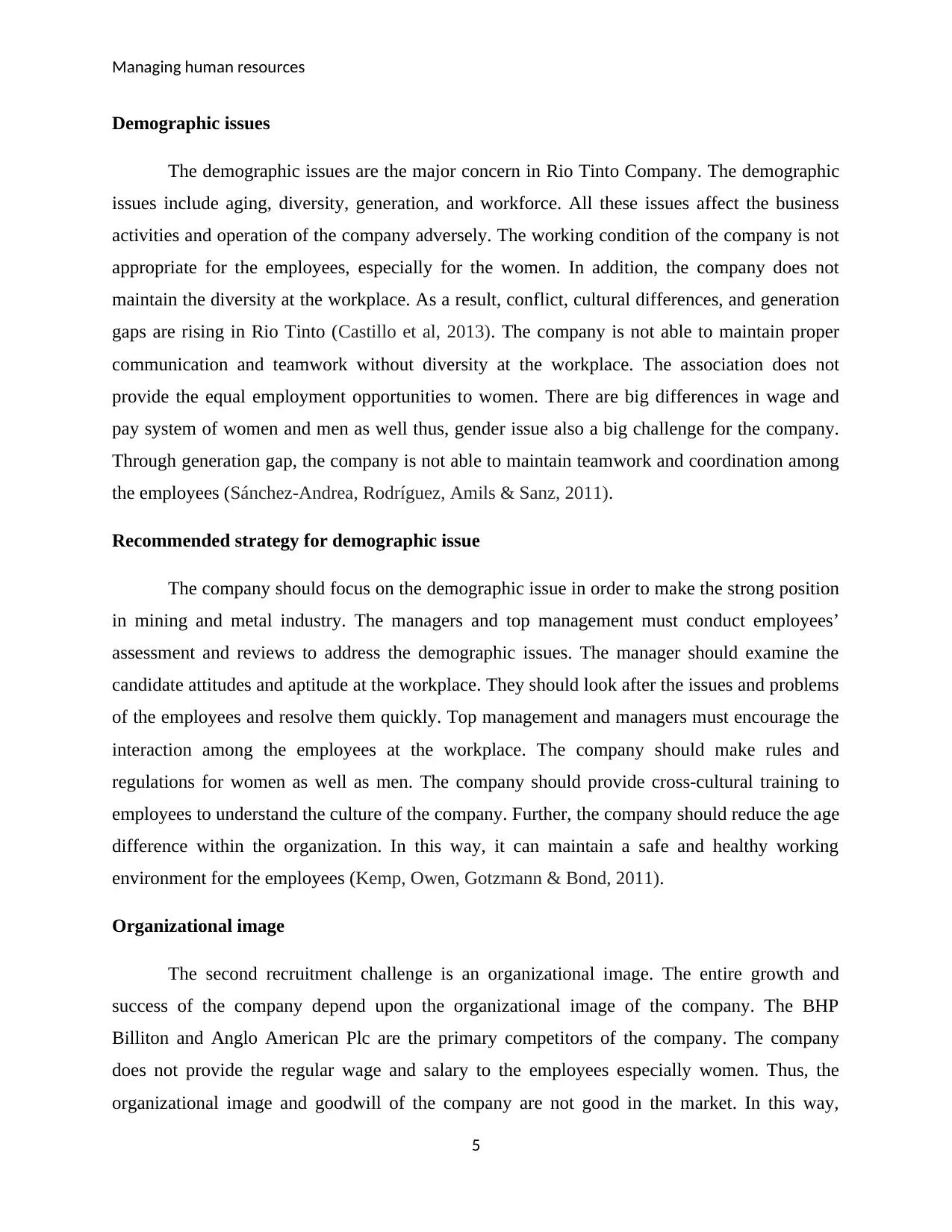
Managing human resources
Demographic issues
The demographic issues are the major concern in Rio Tinto Company. The demographic
issues include aging, diversity, generation, and workforce. All these issues affect the business
activities and operation of the company adversely. The working condition of the company is not
appropriate for the employees, especially for the women. In addition, the company does not
maintain the diversity at the workplace. As a result, conflict, cultural differences, and generation
gaps are rising in Rio Tinto (Castillo et al, 2013). The company is not able to maintain proper
communication and teamwork without diversity at the workplace. The association does not
provide the equal employment opportunities to women. There are big differences in wage and
pay system of women and men as well thus, gender issue also a big challenge for the company.
Through generation gap, the company is not able to maintain teamwork and coordination among
the employees (Sánchez-Andrea, Rodríguez, Amils & Sanz, 2011).
Recommended strategy for demographic issue
The company should focus on the demographic issue in order to make the strong position
in mining and metal industry. The managers and top management must conduct employees’
assessment and reviews to address the demographic issues. The manager should examine the
candidate attitudes and aptitude at the workplace. They should look after the issues and problems
of the employees and resolve them quickly. Top management and managers must encourage the
interaction among the employees at the workplace. The company should make rules and
regulations for women as well as men. The company should provide cross-cultural training to
employees to understand the culture of the company. Further, the company should reduce the age
difference within the organization. In this way, it can maintain a safe and healthy working
environment for the employees (Kemp, Owen, Gotzmann & Bond, 2011).
Organizational image
The second recruitment challenge is an organizational image. The entire growth and
success of the company depend upon the organizational image of the company. The BHP
Billiton and Anglo American Plc are the primary competitors of the company. The company
does not provide the regular wage and salary to the employees especially women. Thus, the
organizational image and goodwill of the company are not good in the market. In this way,
5
Demographic issues
The demographic issues are the major concern in Rio Tinto Company. The demographic
issues include aging, diversity, generation, and workforce. All these issues affect the business
activities and operation of the company adversely. The working condition of the company is not
appropriate for the employees, especially for the women. In addition, the company does not
maintain the diversity at the workplace. As a result, conflict, cultural differences, and generation
gaps are rising in Rio Tinto (Castillo et al, 2013). The company is not able to maintain proper
communication and teamwork without diversity at the workplace. The association does not
provide the equal employment opportunities to women. There are big differences in wage and
pay system of women and men as well thus, gender issue also a big challenge for the company.
Through generation gap, the company is not able to maintain teamwork and coordination among
the employees (Sánchez-Andrea, Rodríguez, Amils & Sanz, 2011).
Recommended strategy for demographic issue
The company should focus on the demographic issue in order to make the strong position
in mining and metal industry. The managers and top management must conduct employees’
assessment and reviews to address the demographic issues. The manager should examine the
candidate attitudes and aptitude at the workplace. They should look after the issues and problems
of the employees and resolve them quickly. Top management and managers must encourage the
interaction among the employees at the workplace. The company should make rules and
regulations for women as well as men. The company should provide cross-cultural training to
employees to understand the culture of the company. Further, the company should reduce the age
difference within the organization. In this way, it can maintain a safe and healthy working
environment for the employees (Kemp, Owen, Gotzmann & Bond, 2011).
Organizational image
The second recruitment challenge is an organizational image. The entire growth and
success of the company depend upon the organizational image of the company. The BHP
Billiton and Anglo American Plc are the primary competitors of the company. The company
does not provide the regular wage and salary to the employees especially women. Thus, the
organizational image and goodwill of the company are not good in the market. In this way,
5
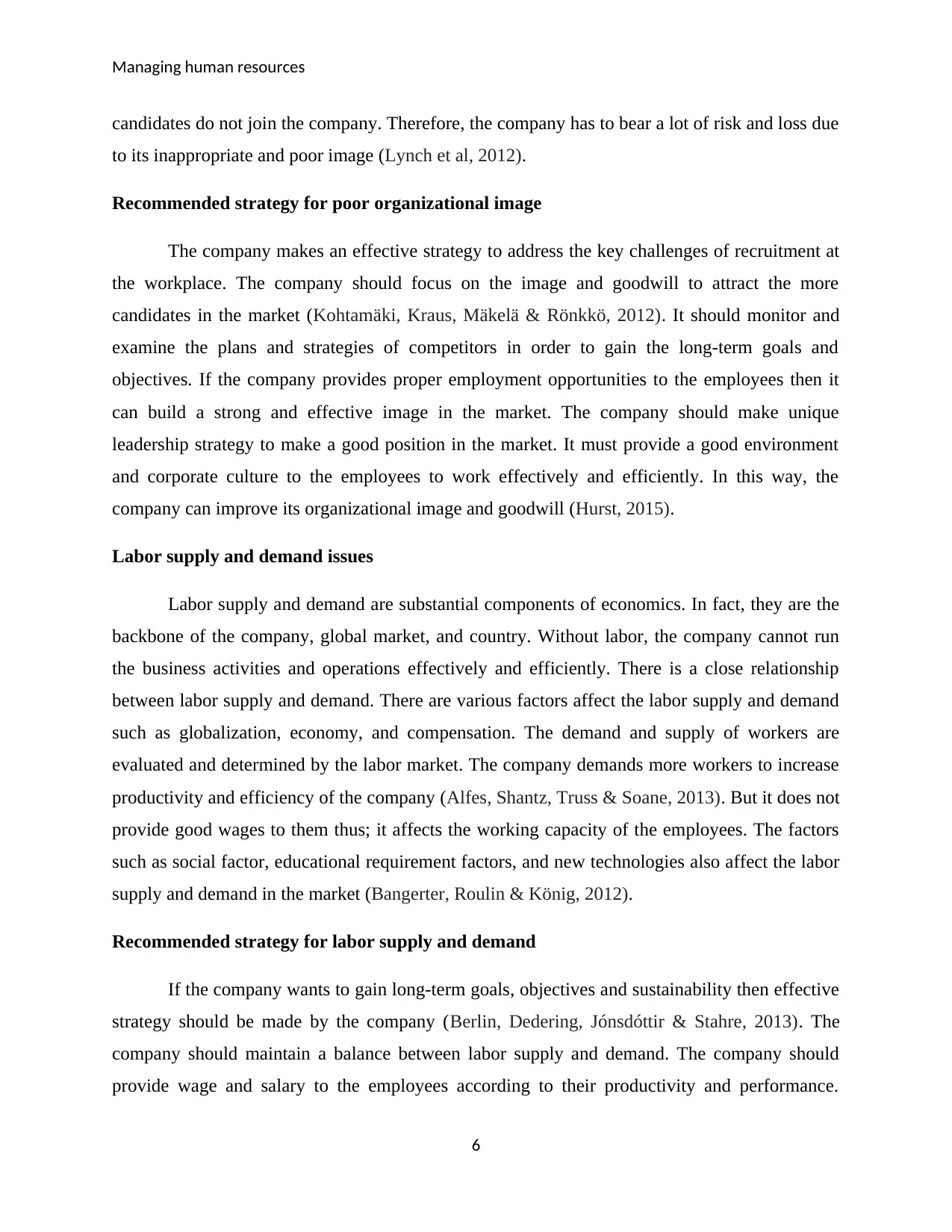
Managing human resources
candidates do not join the company. Therefore, the company has to bear a lot of risk and loss due
to its inappropriate and poor image (Lynch et al, 2012).
Recommended strategy for poor organizational image
The company makes an effective strategy to address the key challenges of recruitment at
the workplace. The company should focus on the image and goodwill to attract the more
candidates in the market (Kohtamäki, Kraus, Mäkelä & Rönkkö, 2012). It should monitor and
examine the plans and strategies of competitors in order to gain the long-term goals and
objectives. If the company provides proper employment opportunities to the employees then it
can build a strong and effective image in the market. The company should make unique
leadership strategy to make a good position in the market. It must provide a good environment
and corporate culture to the employees to work effectively and efficiently. In this way, the
company can improve its organizational image and goodwill (Hurst, 2015).
Labor supply and demand issues
Labor supply and demand are substantial components of economics. In fact, they are the
backbone of the company, global market, and country. Without labor, the company cannot run
the business activities and operations effectively and efficiently. There is a close relationship
between labor supply and demand. There are various factors affect the labor supply and demand
such as globalization, economy, and compensation. The demand and supply of workers are
evaluated and determined by the labor market. The company demands more workers to increase
productivity and efficiency of the company (Alfes, Shantz, Truss & Soane, 2013). But it does not
provide good wages to them thus; it affects the working capacity of the employees. The factors
such as social factor, educational requirement factors, and new technologies also affect the labor
supply and demand in the market (Bangerter, Roulin & König, 2012).
Recommended strategy for labor supply and demand
If the company wants to gain long-term goals, objectives and sustainability then effective
strategy should be made by the company (Berlin, Dedering, Jónsdóttir & Stahre, 2013). The
company should maintain a balance between labor supply and demand. The company should
provide wage and salary to the employees according to their productivity and performance.
6
candidates do not join the company. Therefore, the company has to bear a lot of risk and loss due
to its inappropriate and poor image (Lynch et al, 2012).
Recommended strategy for poor organizational image
The company makes an effective strategy to address the key challenges of recruitment at
the workplace. The company should focus on the image and goodwill to attract the more
candidates in the market (Kohtamäki, Kraus, Mäkelä & Rönkkö, 2012). It should monitor and
examine the plans and strategies of competitors in order to gain the long-term goals and
objectives. If the company provides proper employment opportunities to the employees then it
can build a strong and effective image in the market. The company should make unique
leadership strategy to make a good position in the market. It must provide a good environment
and corporate culture to the employees to work effectively and efficiently. In this way, the
company can improve its organizational image and goodwill (Hurst, 2015).
Labor supply and demand issues
Labor supply and demand are substantial components of economics. In fact, they are the
backbone of the company, global market, and country. Without labor, the company cannot run
the business activities and operations effectively and efficiently. There is a close relationship
between labor supply and demand. There are various factors affect the labor supply and demand
such as globalization, economy, and compensation. The demand and supply of workers are
evaluated and determined by the labor market. The company demands more workers to increase
productivity and efficiency of the company (Alfes, Shantz, Truss & Soane, 2013). But it does not
provide good wages to them thus; it affects the working capacity of the employees. The factors
such as social factor, educational requirement factors, and new technologies also affect the labor
supply and demand in the market (Bangerter, Roulin & König, 2012).
Recommended strategy for labor supply and demand
If the company wants to gain long-term goals, objectives and sustainability then effective
strategy should be made by the company (Berlin, Dedering, Jónsdóttir & Stahre, 2013). The
company should maintain a balance between labor supply and demand. The company should
provide wage and salary to the employees according to their productivity and performance.
6
⊘ This is a preview!⊘
Do you want full access?
Subscribe today to unlock all pages.

Trusted by 1+ million students worldwide
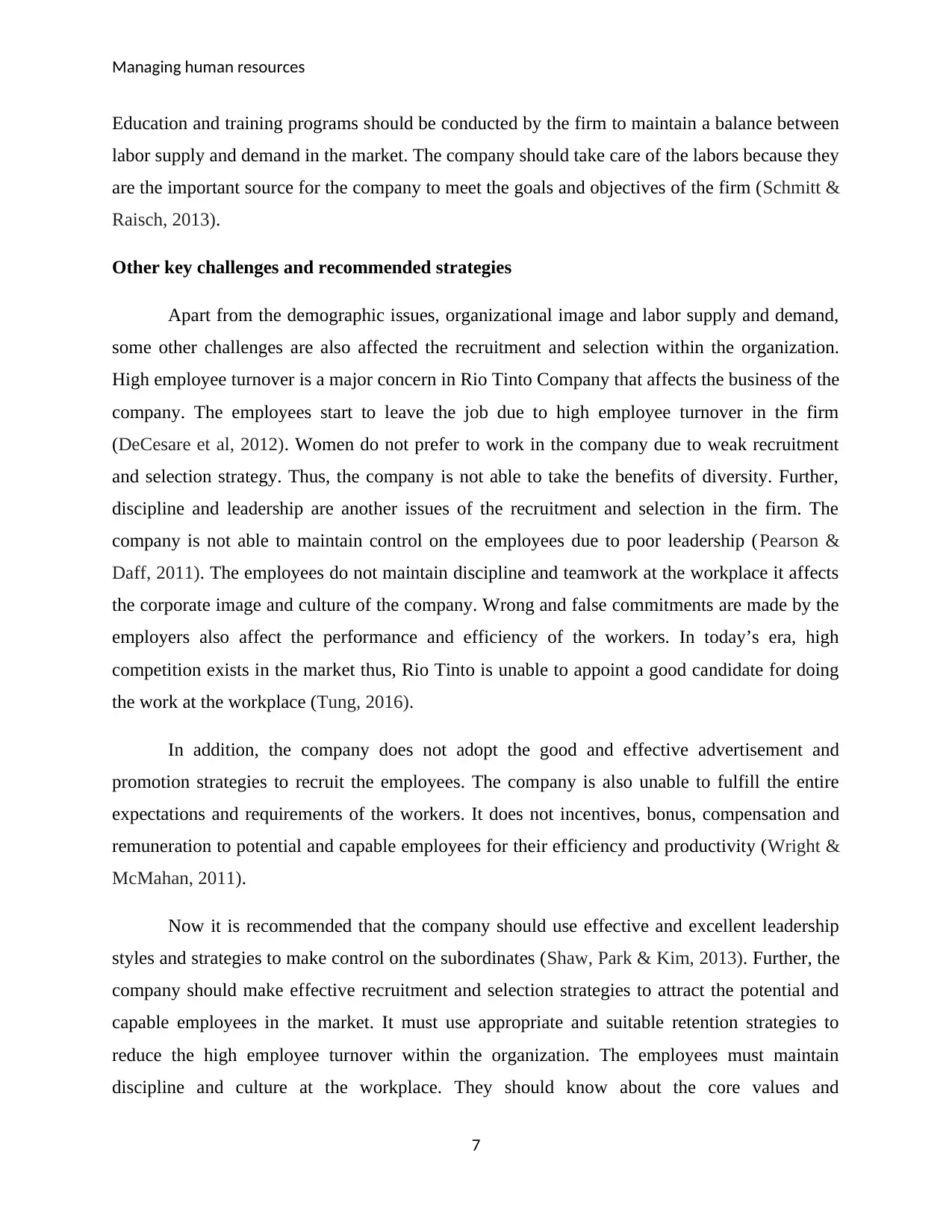
Managing human resources
Education and training programs should be conducted by the firm to maintain a balance between
labor supply and demand in the market. The company should take care of the labors because they
are the important source for the company to meet the goals and objectives of the firm (Schmitt &
Raisch, 2013).
Other key challenges and recommended strategies
Apart from the demographic issues, organizational image and labor supply and demand,
some other challenges are also affected the recruitment and selection within the organization.
High employee turnover is a major concern in Rio Tinto Company that affects the business of the
company. The employees start to leave the job due to high employee turnover in the firm
(DeCesare et al, 2012). Women do not prefer to work in the company due to weak recruitment
and selection strategy. Thus, the company is not able to take the benefits of diversity. Further,
discipline and leadership are another issues of the recruitment and selection in the firm. The
company is not able to maintain control on the employees due to poor leadership (Pearson &
Daff, 2011). The employees do not maintain discipline and teamwork at the workplace it affects
the corporate image and culture of the company. Wrong and false commitments are made by the
employers also affect the performance and efficiency of the workers. In today’s era, high
competition exists in the market thus, Rio Tinto is unable to appoint a good candidate for doing
the work at the workplace (Tung, 2016).
In addition, the company does not adopt the good and effective advertisement and
promotion strategies to recruit the employees. The company is also unable to fulfill the entire
expectations and requirements of the workers. It does not incentives, bonus, compensation and
remuneration to potential and capable employees for their efficiency and productivity (Wright &
McMahan, 2011).
Now it is recommended that the company should use effective and excellent leadership
styles and strategies to make control on the subordinates (Shaw, Park & Kim, 2013). Further, the
company should make effective recruitment and selection strategies to attract the potential and
capable employees in the market. It must use appropriate and suitable retention strategies to
reduce the high employee turnover within the organization. The employees must maintain
discipline and culture at the workplace. They should know about the core values and
7
Education and training programs should be conducted by the firm to maintain a balance between
labor supply and demand in the market. The company should take care of the labors because they
are the important source for the company to meet the goals and objectives of the firm (Schmitt &
Raisch, 2013).
Other key challenges and recommended strategies
Apart from the demographic issues, organizational image and labor supply and demand,
some other challenges are also affected the recruitment and selection within the organization.
High employee turnover is a major concern in Rio Tinto Company that affects the business of the
company. The employees start to leave the job due to high employee turnover in the firm
(DeCesare et al, 2012). Women do not prefer to work in the company due to weak recruitment
and selection strategy. Thus, the company is not able to take the benefits of diversity. Further,
discipline and leadership are another issues of the recruitment and selection in the firm. The
company is not able to maintain control on the employees due to poor leadership (Pearson &
Daff, 2011). The employees do not maintain discipline and teamwork at the workplace it affects
the corporate image and culture of the company. Wrong and false commitments are made by the
employers also affect the performance and efficiency of the workers. In today’s era, high
competition exists in the market thus, Rio Tinto is unable to appoint a good candidate for doing
the work at the workplace (Tung, 2016).
In addition, the company does not adopt the good and effective advertisement and
promotion strategies to recruit the employees. The company is also unable to fulfill the entire
expectations and requirements of the workers. It does not incentives, bonus, compensation and
remuneration to potential and capable employees for their efficiency and productivity (Wright &
McMahan, 2011).
Now it is recommended that the company should use effective and excellent leadership
styles and strategies to make control on the subordinates (Shaw, Park & Kim, 2013). Further, the
company should make effective recruitment and selection strategies to attract the potential and
capable employees in the market. It must use appropriate and suitable retention strategies to
reduce the high employee turnover within the organization. The employees must maintain
discipline and culture at the workplace. They should know about the core values and
7
Paraphrase This Document
Need a fresh take? Get an instant paraphrase of this document with our AI Paraphraser
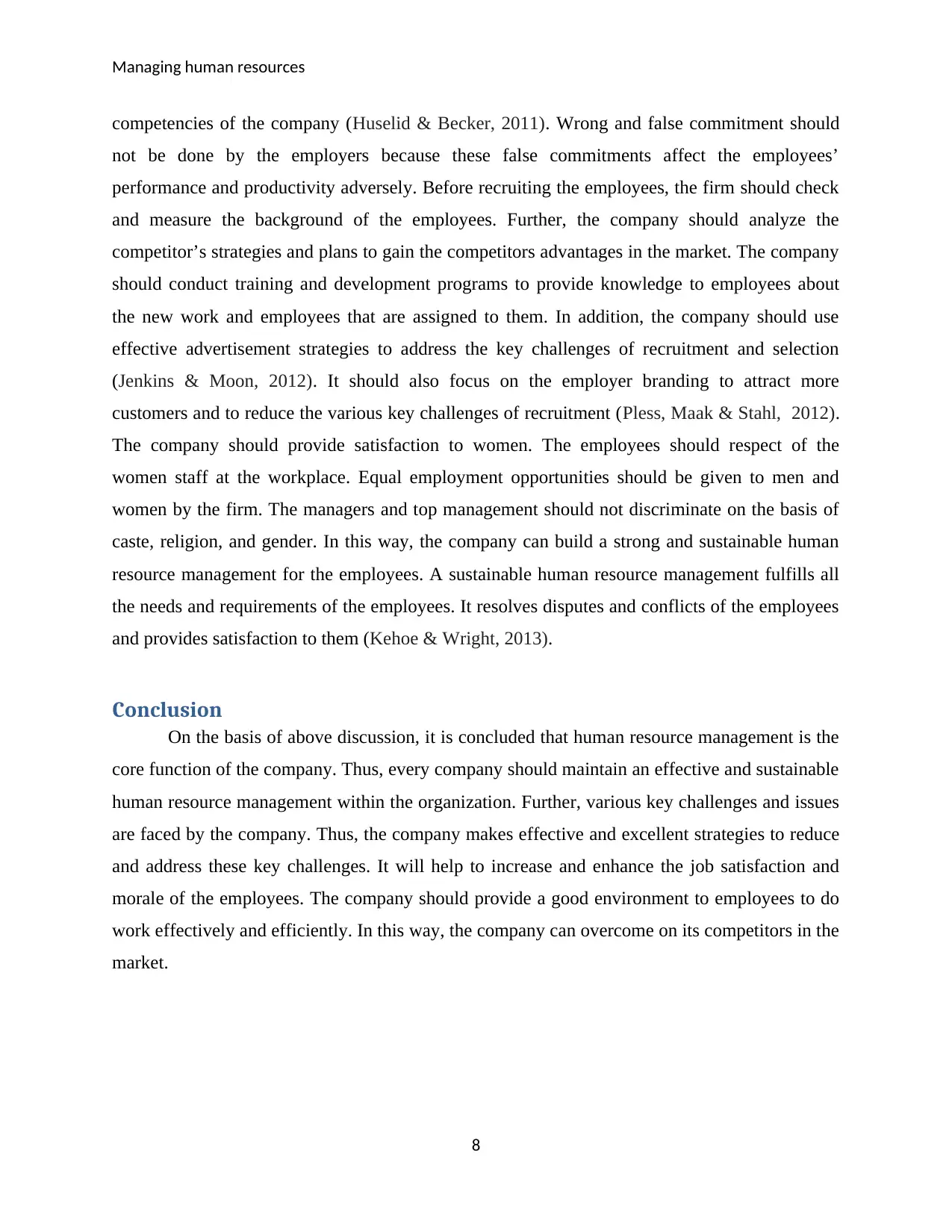
Managing human resources
competencies of the company (Huselid & Becker, 2011). Wrong and false commitment should
not be done by the employers because these false commitments affect the employees’
performance and productivity adversely. Before recruiting the employees, the firm should check
and measure the background of the employees. Further, the company should analyze the
competitor’s strategies and plans to gain the competitors advantages in the market. The company
should conduct training and development programs to provide knowledge to employees about
the new work and employees that are assigned to them. In addition, the company should use
effective advertisement strategies to address the key challenges of recruitment and selection
(Jenkins & Moon, 2012). It should also focus on the employer branding to attract more
customers and to reduce the various key challenges of recruitment (Pless, Maak & Stahl, 2012).
The company should provide satisfaction to women. The employees should respect of the
women staff at the workplace. Equal employment opportunities should be given to men and
women by the firm. The managers and top management should not discriminate on the basis of
caste, religion, and gender. In this way, the company can build a strong and sustainable human
resource management for the employees. A sustainable human resource management fulfills all
the needs and requirements of the employees. It resolves disputes and conflicts of the employees
and provides satisfaction to them (Kehoe & Wright, 2013).
Conclusion
On the basis of above discussion, it is concluded that human resource management is the
core function of the company. Thus, every company should maintain an effective and sustainable
human resource management within the organization. Further, various key challenges and issues
are faced by the company. Thus, the company makes effective and excellent strategies to reduce
and address these key challenges. It will help to increase and enhance the job satisfaction and
morale of the employees. The company should provide a good environment to employees to do
work effectively and efficiently. In this way, the company can overcome on its competitors in the
market.
8
competencies of the company (Huselid & Becker, 2011). Wrong and false commitment should
not be done by the employers because these false commitments affect the employees’
performance and productivity adversely. Before recruiting the employees, the firm should check
and measure the background of the employees. Further, the company should analyze the
competitor’s strategies and plans to gain the competitors advantages in the market. The company
should conduct training and development programs to provide knowledge to employees about
the new work and employees that are assigned to them. In addition, the company should use
effective advertisement strategies to address the key challenges of recruitment and selection
(Jenkins & Moon, 2012). It should also focus on the employer branding to attract more
customers and to reduce the various key challenges of recruitment (Pless, Maak & Stahl, 2012).
The company should provide satisfaction to women. The employees should respect of the
women staff at the workplace. Equal employment opportunities should be given to men and
women by the firm. The managers and top management should not discriminate on the basis of
caste, religion, and gender. In this way, the company can build a strong and sustainable human
resource management for the employees. A sustainable human resource management fulfills all
the needs and requirements of the employees. It resolves disputes and conflicts of the employees
and provides satisfaction to them (Kehoe & Wright, 2013).
Conclusion
On the basis of above discussion, it is concluded that human resource management is the
core function of the company. Thus, every company should maintain an effective and sustainable
human resource management within the organization. Further, various key challenges and issues
are faced by the company. Thus, the company makes effective and excellent strategies to reduce
and address these key challenges. It will help to increase and enhance the job satisfaction and
morale of the employees. The company should provide a good environment to employees to do
work effectively and efficiently. In this way, the company can overcome on its competitors in the
market.
8
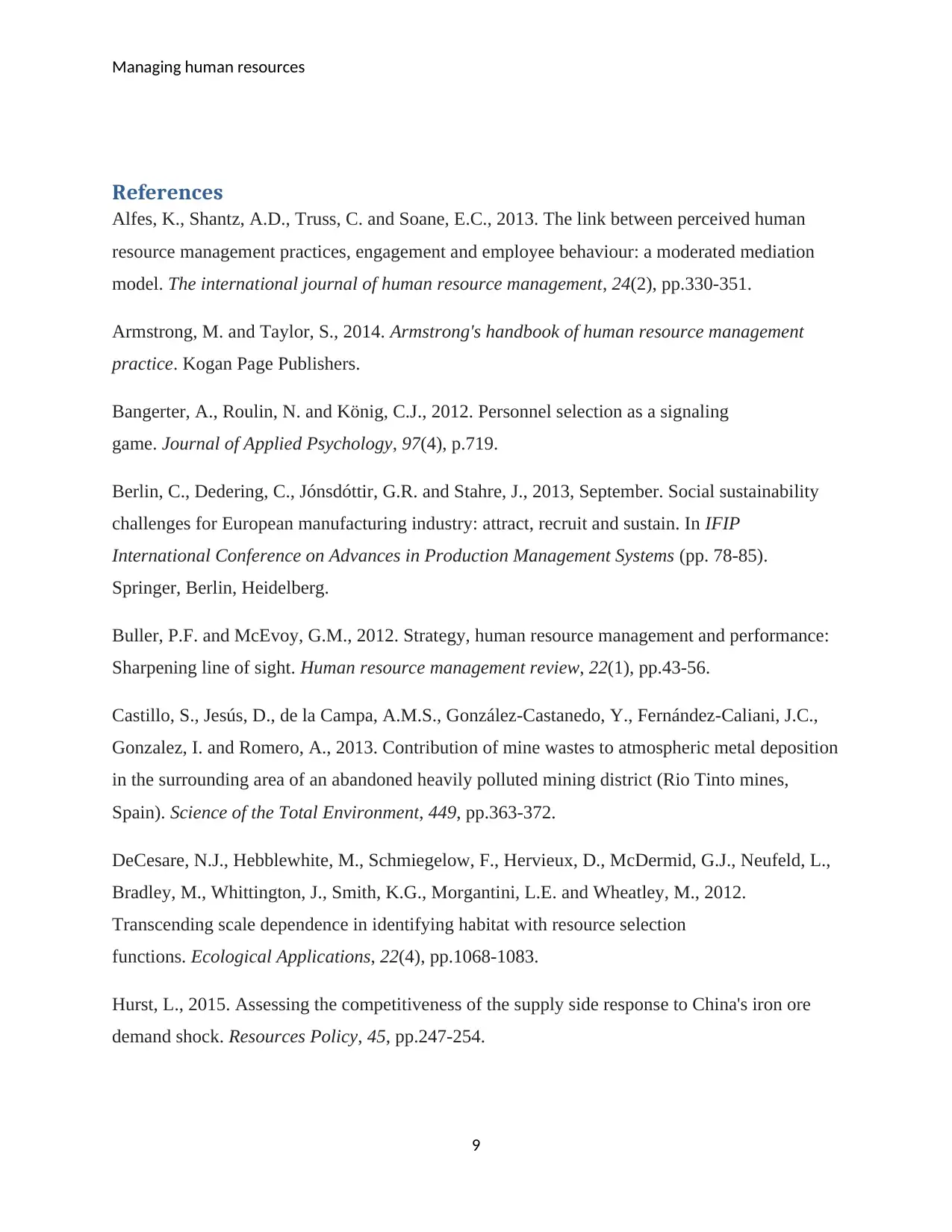
Managing human resources
References
Alfes, K., Shantz, A.D., Truss, C. and Soane, E.C., 2013. The link between perceived human
resource management practices, engagement and employee behaviour: a moderated mediation
model. The international journal of human resource management, 24(2), pp.330-351.
Armstrong, M. and Taylor, S., 2014. Armstrong's handbook of human resource management
practice. Kogan Page Publishers.
Bangerter, A., Roulin, N. and König, C.J., 2012. Personnel selection as a signaling
game. Journal of Applied Psychology, 97(4), p.719.
Berlin, C., Dedering, C., Jónsdóttir, G.R. and Stahre, J., 2013, September. Social sustainability
challenges for European manufacturing industry: attract, recruit and sustain. In IFIP
International Conference on Advances in Production Management Systems (pp. 78-85).
Springer, Berlin, Heidelberg.
Buller, P.F. and McEvoy, G.M., 2012. Strategy, human resource management and performance:
Sharpening line of sight. Human resource management review, 22(1), pp.43-56.
Castillo, S., Jesús, D., de la Campa, A.M.S., González-Castanedo, Y., Fernández-Caliani, J.C.,
Gonzalez, I. and Romero, A., 2013. Contribution of mine wastes to atmospheric metal deposition
in the surrounding area of an abandoned heavily polluted mining district (Rio Tinto mines,
Spain). Science of the Total Environment, 449, pp.363-372.
DeCesare, N.J., Hebblewhite, M., Schmiegelow, F., Hervieux, D., McDermid, G.J., Neufeld, L.,
Bradley, M., Whittington, J., Smith, K.G., Morgantini, L.E. and Wheatley, M., 2012.
Transcending scale dependence in identifying habitat with resource selection
functions. Ecological Applications, 22(4), pp.1068-1083.
Hurst, L., 2015. Assessing the competitiveness of the supply side response to China's iron ore
demand shock. Resources Policy, 45, pp.247-254.
9
References
Alfes, K., Shantz, A.D., Truss, C. and Soane, E.C., 2013. The link between perceived human
resource management practices, engagement and employee behaviour: a moderated mediation
model. The international journal of human resource management, 24(2), pp.330-351.
Armstrong, M. and Taylor, S., 2014. Armstrong's handbook of human resource management
practice. Kogan Page Publishers.
Bangerter, A., Roulin, N. and König, C.J., 2012. Personnel selection as a signaling
game. Journal of Applied Psychology, 97(4), p.719.
Berlin, C., Dedering, C., Jónsdóttir, G.R. and Stahre, J., 2013, September. Social sustainability
challenges for European manufacturing industry: attract, recruit and sustain. In IFIP
International Conference on Advances in Production Management Systems (pp. 78-85).
Springer, Berlin, Heidelberg.
Buller, P.F. and McEvoy, G.M., 2012. Strategy, human resource management and performance:
Sharpening line of sight. Human resource management review, 22(1), pp.43-56.
Castillo, S., Jesús, D., de la Campa, A.M.S., González-Castanedo, Y., Fernández-Caliani, J.C.,
Gonzalez, I. and Romero, A., 2013. Contribution of mine wastes to atmospheric metal deposition
in the surrounding area of an abandoned heavily polluted mining district (Rio Tinto mines,
Spain). Science of the Total Environment, 449, pp.363-372.
DeCesare, N.J., Hebblewhite, M., Schmiegelow, F., Hervieux, D., McDermid, G.J., Neufeld, L.,
Bradley, M., Whittington, J., Smith, K.G., Morgantini, L.E. and Wheatley, M., 2012.
Transcending scale dependence in identifying habitat with resource selection
functions. Ecological Applications, 22(4), pp.1068-1083.
Hurst, L., 2015. Assessing the competitiveness of the supply side response to China's iron ore
demand shock. Resources Policy, 45, pp.247-254.
9
⊘ This is a preview!⊘
Do you want full access?
Subscribe today to unlock all pages.

Trusted by 1+ million students worldwide
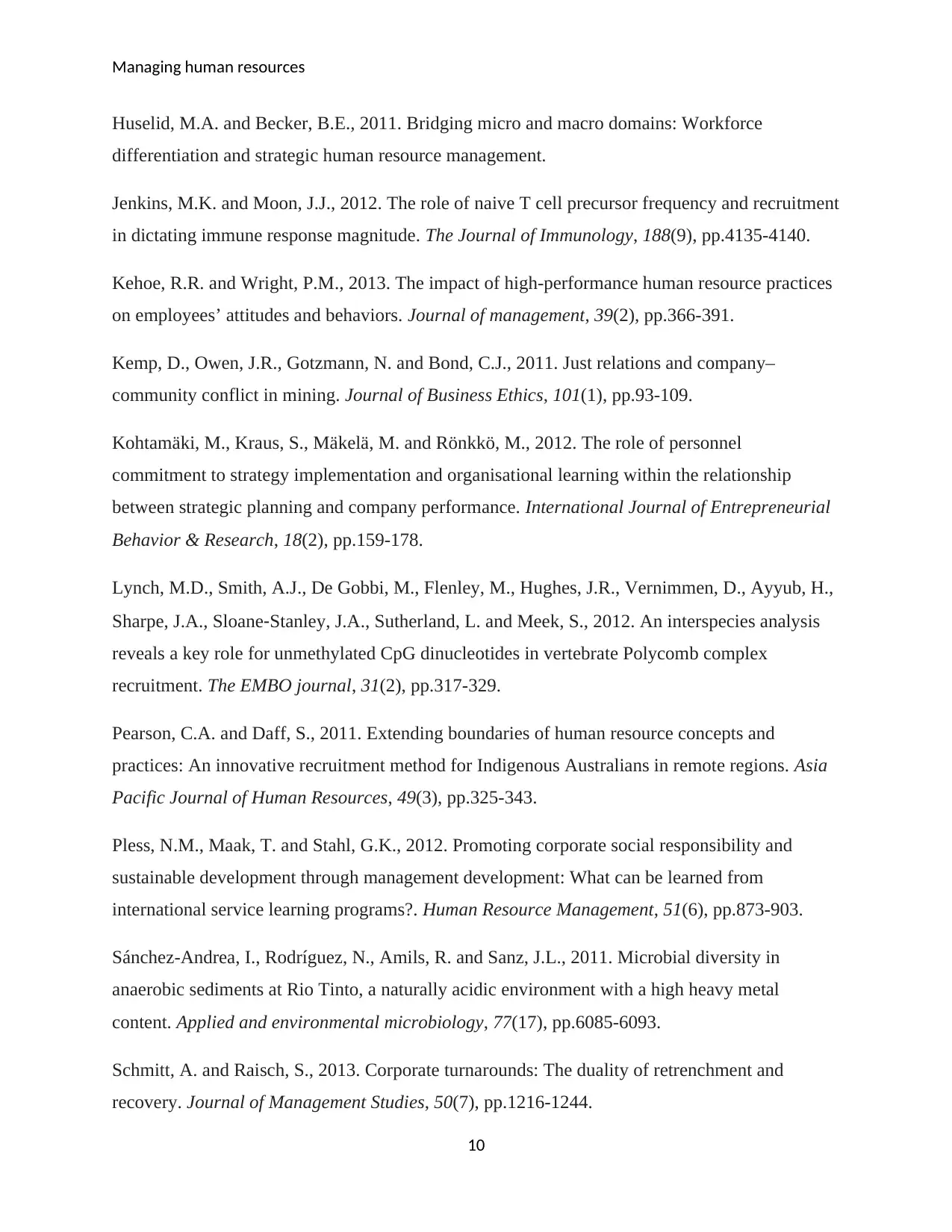
Managing human resources
Huselid, M.A. and Becker, B.E., 2011. Bridging micro and macro domains: Workforce
differentiation and strategic human resource management.
Jenkins, M.K. and Moon, J.J., 2012. The role of naive T cell precursor frequency and recruitment
in dictating immune response magnitude. The Journal of Immunology, 188(9), pp.4135-4140.
Kehoe, R.R. and Wright, P.M., 2013. The impact of high-performance human resource practices
on employees’ attitudes and behaviors. Journal of management, 39(2), pp.366-391.
Kemp, D., Owen, J.R., Gotzmann, N. and Bond, C.J., 2011. Just relations and company–
community conflict in mining. Journal of Business Ethics, 101(1), pp.93-109.
Kohtamäki, M., Kraus, S., Mäkelä, M. and Rönkkö, M., 2012. The role of personnel
commitment to strategy implementation and organisational learning within the relationship
between strategic planning and company performance. International Journal of Entrepreneurial
Behavior & Research, 18(2), pp.159-178.
Lynch, M.D., Smith, A.J., De Gobbi, M., Flenley, M., Hughes, J.R., Vernimmen, D., Ayyub, H.,
Sharpe, J.A., Sloane‐Stanley, J.A., Sutherland, L. and Meek, S., 2012. An interspecies analysis
reveals a key role for unmethylated CpG dinucleotides in vertebrate Polycomb complex
recruitment. The EMBO journal, 31(2), pp.317-329.
Pearson, C.A. and Daff, S., 2011. Extending boundaries of human resource concepts and
practices: An innovative recruitment method for Indigenous Australians in remote regions. Asia
Pacific Journal of Human Resources, 49(3), pp.325-343.
Pless, N.M., Maak, T. and Stahl, G.K., 2012. Promoting corporate social responsibility and
sustainable development through management development: What can be learned from
international service learning programs?. Human Resource Management, 51(6), pp.873-903.
Sánchez-Andrea, I., Rodríguez, N., Amils, R. and Sanz, J.L., 2011. Microbial diversity in
anaerobic sediments at Rio Tinto, a naturally acidic environment with a high heavy metal
content. Applied and environmental microbiology, 77(17), pp.6085-6093.
Schmitt, A. and Raisch, S., 2013. Corporate turnarounds: The duality of retrenchment and
recovery. Journal of Management Studies, 50(7), pp.1216-1244.
10
Huselid, M.A. and Becker, B.E., 2011. Bridging micro and macro domains: Workforce
differentiation and strategic human resource management.
Jenkins, M.K. and Moon, J.J., 2012. The role of naive T cell precursor frequency and recruitment
in dictating immune response magnitude. The Journal of Immunology, 188(9), pp.4135-4140.
Kehoe, R.R. and Wright, P.M., 2013. The impact of high-performance human resource practices
on employees’ attitudes and behaviors. Journal of management, 39(2), pp.366-391.
Kemp, D., Owen, J.R., Gotzmann, N. and Bond, C.J., 2011. Just relations and company–
community conflict in mining. Journal of Business Ethics, 101(1), pp.93-109.
Kohtamäki, M., Kraus, S., Mäkelä, M. and Rönkkö, M., 2012. The role of personnel
commitment to strategy implementation and organisational learning within the relationship
between strategic planning and company performance. International Journal of Entrepreneurial
Behavior & Research, 18(2), pp.159-178.
Lynch, M.D., Smith, A.J., De Gobbi, M., Flenley, M., Hughes, J.R., Vernimmen, D., Ayyub, H.,
Sharpe, J.A., Sloane‐Stanley, J.A., Sutherland, L. and Meek, S., 2012. An interspecies analysis
reveals a key role for unmethylated CpG dinucleotides in vertebrate Polycomb complex
recruitment. The EMBO journal, 31(2), pp.317-329.
Pearson, C.A. and Daff, S., 2011. Extending boundaries of human resource concepts and
practices: An innovative recruitment method for Indigenous Australians in remote regions. Asia
Pacific Journal of Human Resources, 49(3), pp.325-343.
Pless, N.M., Maak, T. and Stahl, G.K., 2012. Promoting corporate social responsibility and
sustainable development through management development: What can be learned from
international service learning programs?. Human Resource Management, 51(6), pp.873-903.
Sánchez-Andrea, I., Rodríguez, N., Amils, R. and Sanz, J.L., 2011. Microbial diversity in
anaerobic sediments at Rio Tinto, a naturally acidic environment with a high heavy metal
content. Applied and environmental microbiology, 77(17), pp.6085-6093.
Schmitt, A. and Raisch, S., 2013. Corporate turnarounds: The duality of retrenchment and
recovery. Journal of Management Studies, 50(7), pp.1216-1244.
10
Paraphrase This Document
Need a fresh take? Get an instant paraphrase of this document with our AI Paraphraser
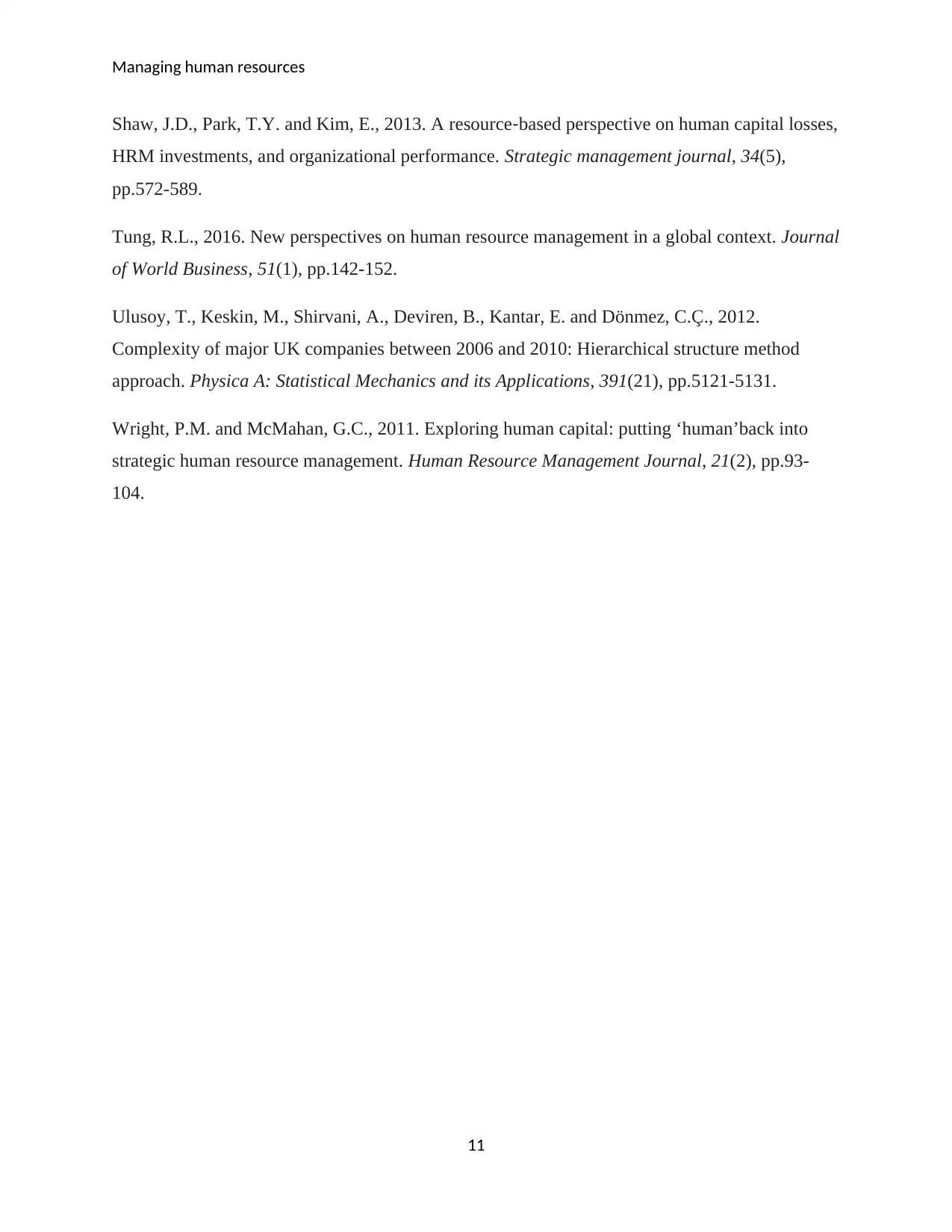
Managing human resources
Shaw, J.D., Park, T.Y. and Kim, E., 2013. A resource‐based perspective on human capital losses,
HRM investments, and organizational performance. Strategic management journal, 34(5),
pp.572-589.
Tung, R.L., 2016. New perspectives on human resource management in a global context. Journal
of World Business, 51(1), pp.142-152.
Ulusoy, T., Keskin, M., Shirvani, A., Deviren, B., Kantar, E. and Dönmez, C.Ç., 2012.
Complexity of major UK companies between 2006 and 2010: Hierarchical structure method
approach. Physica A: Statistical Mechanics and its Applications, 391(21), pp.5121-5131.
Wright, P.M. and McMahan, G.C., 2011. Exploring human capital: putting ‘human’back into
strategic human resource management. Human Resource Management Journal, 21(2), pp.93-
104.
11
Shaw, J.D., Park, T.Y. and Kim, E., 2013. A resource‐based perspective on human capital losses,
HRM investments, and organizational performance. Strategic management journal, 34(5),
pp.572-589.
Tung, R.L., 2016. New perspectives on human resource management in a global context. Journal
of World Business, 51(1), pp.142-152.
Ulusoy, T., Keskin, M., Shirvani, A., Deviren, B., Kantar, E. and Dönmez, C.Ç., 2012.
Complexity of major UK companies between 2006 and 2010: Hierarchical structure method
approach. Physica A: Statistical Mechanics and its Applications, 391(21), pp.5121-5131.
Wright, P.M. and McMahan, G.C., 2011. Exploring human capital: putting ‘human’back into
strategic human resource management. Human Resource Management Journal, 21(2), pp.93-
104.
11
1 out of 11
Related Documents
Your All-in-One AI-Powered Toolkit for Academic Success.
+13062052269
info@desklib.com
Available 24*7 on WhatsApp / Email
![[object Object]](/_next/static/media/star-bottom.7253800d.svg)
Unlock your academic potential
Copyright © 2020–2025 A2Z Services. All Rights Reserved. Developed and managed by ZUCOL.





